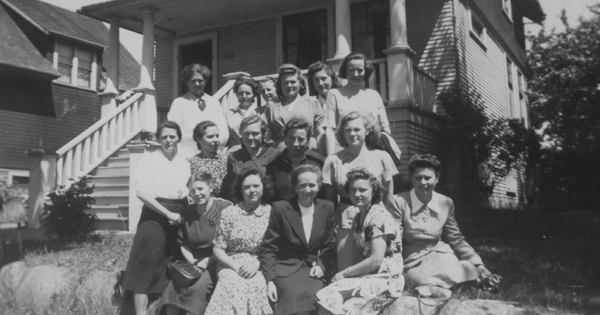- Daughters in the City, Mennonite Maids in Vancouver; 1931-61
- Fernwood Press (2013)
EXPERIENCED MAID WANTED -- One who reflects on a good home; wages $7 month.
In November 1937, a group of young immigrant women pooled their money and bought a two-storey house in South Vancouver.
That they made this purchase at a time when the country was easing out of the Great Depression was no small feat. That they did so with money saved from their salaries as domestic maids, minus what was sent home to pay off family debts, was an even greater accomplishment.
The house, at 6363 Windsor Street, was the Bethel Home. It was one of two "Girls' Homes" in the city that served thousands of young Mennonite women who left home to work in upper and middle-class households in Vancouver from the 1930s to '60s.
Ruth Derksen Siemens, a first-generation Canadian who grew up in Vancouver, has close ties to this largely forgotten aspect of city history. Her mother and 14 aunts from both sides of her family either lived at or found work through a Girls' Home. She grew up hearing their stories, she says, "and just took it for granted that that's just what women did."
It wasn't until Derksen Siemens was 41, working on her undergraduate degree in English at Simon Fraser University, that she decided to take a closer look at the homes.
She recalls introducing herself as a Russian Mennonite at a third-year women's studies class. It opened a floodgate of questions from her mostly younger classmates. When the subject of the Girls' Homes came up, her professor was curious. She assured Derksen Siemens that this story, her story, was an important one and worth telling to the wider world.
Derksen Siemens began interviewing her own family members and other women who had been part of the Girls' Homes.
"The more I learned, the more I wanted to honour these women," she says.
She pored over historical documents, collected photographs and ultimately interviewed hundreds of other "girls" now in their 80s and 90s. The fruits of her labour, Daughters in the City, was published 20 years after she first turned an academic eye to her family's history. The book is an homage to the early wave of immigrant women whose labour had a huge impact on their families and the country.
Commonality in purpose
Derksen Siemens' aunt, Kay Derksen Rempel, typifies the Mennonite immigrant experience in the 20th century. Kay's parents -- Derksen's grandparents -- were among the 23,000 Mennonite Russian refugees who came to Canada in the 1920s to escape Joseph Stalin's brutal regime.
They incurred large debts in the process. In 1922, representatives from the Canadian Pacific Railway agreed to grant credit to transport refugees from Russia to Canada. Once they arrived, they had to figure out a way to pay it back. According to one report Derksen Siemens uncovered, the total travel debt of the Mennonites in the Fraser Valley was $37,000 as of Nov. 1931.
Farming could sustain the newcomers, but left them with little accessible cash. So they sent their young women to work -- and few jobs could pay as well as domestic work in the big city. Kay was only 14 when she left the Mennonite village of Yarrow, in the Fraser Valley, to become a maid in Vancouver.
"My grandparents did not want to send their daughters into the city, but they were desperate," says Derksen Siemens. "[Kay] was very lonely, she cried a lot, she didn't know the language. But she also felt that she was helping her family, and that made her feel good."
None of the women Derksen Siemens interviewed felt resentment for having to leave home and go to work at such a young age.
"The travel debt united the women in a common ambition and goal," she writes. "Commonality in purpose and loyalty to their community resulted in these young women assisting each other, sharing hotel rooms, and ultimately finding a place where they could live together."
A place of support
Although a few families opened their homes to these Mennonite maids in the early days (who were otherwise forced to sleep in the train station or share cramped hotel rooms until they could find room and board with an employer), the first reference to a Girls' Home appears in a Mennonite Brethren of B.C. report from June 1931.
The Mennonite Brethren church assembly supported the home with ministry, donations of food and clothing, and a salaried matron, but it was the women who paid all other operating costs. Before long, they realized the money paid in rent would be better spent on a mortgage. By 1937, the home was bought and paid for.
Six years later, the women sold the house and purchased a larger one just a few blocks away.
"By now," writes Derksen Siemens, "there were literally hundreds of Mennonite maids in the city of Vancouver."
"During the home's peak in the 1950s, Matron Susie Warkentin reports that 'We could assist the day workers with 1,936 positions.' In 1956, there were 350 Mennonite women matched with 1,700 employers in one month."
Another Girls' Home, the Mary Martha Home, was established by the General Conference Church (a distinct and, at the time, very separate branch of the Mennonite faith) at 6460 St. George Street in 1935. It served slightly fewer but still a significant number of women, placing 283 with employers during the same period in 1956.
The numbers suggest that, at the time, every upper and middle class home in Vancouver would have had a Mennonite maid working for them, says Derksen Siemens. "They were desired, because even though they were immigrants who didn’t speak English, their skin was white," she explains. "They could pass for a French maid."
Both homes served three main purposes: temporary accommodations for girls who were new to the city (they could sleep 10 to 15 at a time), employment agencies, and community centres where women gathered for weekly suppers, theatre and music nights and holidays.
"The beauty of the Girls' Homes," says Derksen Siemens "is that they had a matron."
The matrons who oversaw the homes were a vital resource, much-loved by the young women who had either lost their own mothers in the Soviet revolution or were now living far from them. A matron's main job was answering the phone and matching women with employers, but she also cooked and baked for her charges, and offered moral and emotional support.
Several matrons are profiled in the book, including Katarina "Tina" Lehn, who served at the Mary Martha Home from 1946 until 1957. Derksen Siemens quotes Helen Franz, who describes Miss Lehn as "a perfect person on that job."
"Never being married or had any children herself, here were all these girls, who were in quotation marks 'her girls.' She did an excellent job. She felt responsible to the parents too, you know. I think everybody would say that she loved us."
'Their stories should not be forgotten'
Most of the women Derksen Siemens interviewed spoke of good times at the Girls' Homes, and on the town. "They spoke of streetcar access to anywhere in the city, Sunday afternoons in rowboats at Lost Lagoon, picnics in Stanley Park, downtown shopping trips on 'maid's day off,'" she writes.
While the book alludes to the vulnerability faced by young women living and working in strangers' homes, they aren't detailed. The purpose of the book is not to divulge secrets, or to decode "the euphemisms the women used to mask events," writes Derksen Siemens.
Nonetheless, during interviews she did hear stories of sexual vulnerability and abuse. "These were spoken of in veiled language. They would say things like, 'He would do that if he had the chance,' but they were never specific about what 'that' was," she says.
"I asked [my aunt] if she ever felt afraid for her safety. She said, 'No, I just pushed the dresser up to my door every night.'"
The vulnerabilities faced by domestic workers haven't gone away. Just recently, a Vancouver man was convicted of human trafficking in a case involving his live-in Filipina nanny, who testified that she worked 16-hour days, was paid $500 a month, and was lied to about gaining legal employment in Canada.
Derksen Siemens can't help but wonder what the outcome would have been if there was a place like the Girls' Homes for the new wave of domestic worker immigrants. "If those homes could have stayed open..." she muses.
But both homes closed in the early 1960s, and in both cases it was the male-led church councils that made the decision. "There was an assumption there wasn't a need," says Derksen Siemens. "There was a certain amount of shame and stigma associated with maids. This wave of immigrants had risen to the middle class, and Mennonites didn’t want their daughters doing that work."
But there were still waves of immigrants in the '60s, women coming to do domestic work. "Many still wanted the place, and the community of women," says Derksen Siemens. Of the women she interviewed, they were all saddened, and in the case of one former matron "still very angry" that the church made the decision to close the homes. "How do you pack up 30 years of memories?" she asked.
Derksen Siemens becomes misty-eyed when she speaks of a gathering she held in the late '90s to present the research she'd done for the book. More than 350 former Mennonite maids came out, along with four former matrons who were still alive at the time. "It's still emotional for me," she says. "Remembering was the goal with this project, giving a voice to these women. Their stories should not be forgotten." ![]()
Read more: Labour + Industry
















Tyee Commenting Guidelines
Comments that violate guidelines risk being deleted, and violations may result in a temporary or permanent user ban. Maintain the spirit of good conversation to stay in the discussion.
*Please note The Tyee is not a forum for spreading misinformation about COVID-19, denying its existence or minimizing its risk to public health.
Do:
Do not: